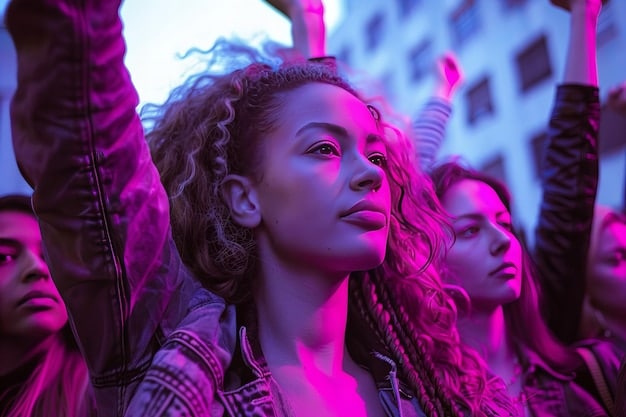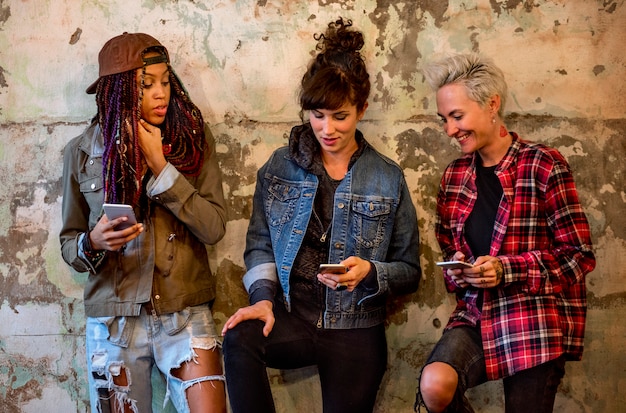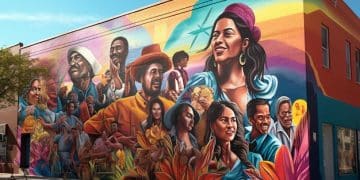Female Rappers Dominating US Hip Hop: A Rise to Power

The landscape of US hip hop is undergoing a significant transformation as female rappers increasingly assert their dominance, reshaping industry norms, influencing mainstream culture, and paving the way for future generations with unparalleled artistic and commercial success.
The evolving soundscape of American urban music testifies to a powerful movement: The Rise of Female Rappers: How Women Are Dominating the Hip Hop Scene in the US. Once a male-dominated genre, hip hop has clearly seen an undeniable surge in female talent, fundamentally altering its dynamics and expanding its global appeal. This isn’t just a fleeting trend; it’s a testament to raw talent, strategic artistry, and a growing cultural appetite for diverse voices within one of the world’s most influential music genres.
From the Underground to the Mainstream: The Evolving Influence
The journey of female rappers within hip hop has been long and multifaceted, marked by periods of quiet struggle and explosive visibility. Historically, women in hip hop often found themselves relegated to secondary roles or confined to narrow archetypes. Despite early pioneers like Salt-N-Pepa and Queen Latifah breaking barriers, widespread mainstream recognition for multiple female artists simultaneously remained elusive for decades.
However, the past decade has witnessed a dramatic shift. Social media, independent distribution platforms, and a growing demand for authentic representation have created fertile ground for female artists to bypass traditional gatekeepers and connect directly with their audiences. This direct engagement has been crucial in building dedicated fan bases that translate into chart success and cultural impact.
Pioneering Voices and Their Legacy
Understanding the present dominance requires acknowledging the powerful foundations laid by those who came before. These artists not only created hit records but also carved out spaces for future generations to thrive.
- Early Trailblazers: Artists like Roxanne Shanté, MC Lyte, and Missy Elliott defied norms, establishing lyrical prowess and creative independence in the early days.
- Bridging Eras: Lil’ Kim and Foxy Brown pushed boundaries with their unapologetic personas and raw lyricism, influencing a new wave of female confidence in rap.
- Sustained Impact: Nicki Minaj’s enduring reign paved the way, proving that a female rapper could achieve and maintain superstar status on par with her male counterparts, opening doors previously thought closed.
These pioneering efforts weren’t just about making music; they were about affirming presence, challenging stereotypes, and cultivating an environment where female expression in hip hop could flourish. Their commitment to their craft and their willingness to push against societal and industry limitations formed the bedrock for the current era of dominance.
Today, the landscape is richer and more varied than ever. Female rappers are not only leading charts but also dictating fashion trends, influencing political discourse, and building formidable business empires. They are no longer defined by their gender in a male-dominated field but rather by their unique artistry and undeniable commercial power.
Lyrical Prowess and Versatility: A New Standard of Artistry
The current wave of female rappers is distinguishing itself not just through sheer presence but through an exceptional display of lyrical prowess and remarkable versatility. Gone are the days when female artists were expected to fit into a singular mold. Today’s leading women in hip hop showcase a diverse range of flows, subject matters, and sonic aesthetics, challenging conventional notions of what a “female rapper” sounds like.
From intricate wordplay and complex rhyming schemes to raw, unfiltered storytelling, these artists are setting new standards for lyrical dexterity. They delve into personal narratives, socio-political commentary, empowerment anthems, and unapologetic expressions of sexuality, all while maintaining an authentic voice that resonates deeply with diverse audiences.
Genre-Bending and Sonic Exploration
One of the most compelling aspects of this new era is the willingness of female rappers to experiment with genres and push sonic boundaries. They are seamlessly blending hip hop with elements of R&B, pop, rock, and even electronic music, creating innovative sounds that appeal to a broader demographic.
- Melodic Rap: Artists are incorporating more singing and melodic hooks into their verses, blurring the lines between rapping and vocal performance.
- Trap Infusion: Embracing the hard-hitting beats and aggressive flows of trap music, while infusing it with their unique lyrical perspectives.
- Global Influences: Incorporating sounds and rhythms from various international music traditions, expanding hip hop’s global appeal even further.
This willingness to experiment not only keeps their music fresh and exciting but also allows them to navigate different mainstream and underground spaces, ensuring longevity and broad appeal. They are not content with sticking to a formula; instead, they are constantly evolving and refining their craft.
The result is a vibrant tapestry of sounds and narratives that reflect the multifaceted experiences of women in contemporary society. Their artistry is a testament to their dedication to their craft, their unwavering commitment to authenticity, and their ability to continuously innovate within a highly competitive industry. This period marks a true renaissance in hip hop lyricism and artistic expression, led by its most dynamic female voices.
Challenging Stereotypes: Redefining Femininity and Power
The rise of female rappers is intrinsically linked to a powerful dismantling of traditional gender stereotypes within hip hop and broader pop culture. For decades, women in the genre were often pigeonholed into roles that limited their creative expression and dictated how they should present themselves. Today, female artists are actively reclaiming narratives around femininity, sexuality, and power, offering diverse and often contradictory portrayals that resonate with a global audience.
They are unapologetically embracing their sexuality, challenging patriarchal norms, and asserting their agency in ways that previous generations might have found difficult or impossible. This isn’t a monolithic movement; rather, it’s a spectrum of expressions ranging from hyper-feminine glamour to aggressive, masculine-coded energy, all underscored by an unwavering sense of self-ownership.
Embracing Authenticity and Breaking Molds
A key aspect of this phenomenon is the emphasis on authenticity. Artists are leveraging social media to present unfiltered versions of themselves, fostering deeper connections with fans who appreciate their honesty and relatability. This often involves discussing topics previously considered taboo, from mental health struggles to societal injustices, making their music not just entertainment but also a form of social commentary.
- Unapologetic Body Positivity: Celebrating all body types and challenging unrealistic beauty standards prevalent in media.
- Financial Independence: Highlighting their achievements in building wealth and emphasizing financial self-sufficiency as a form of empowerment.
- Vulnerability and Strength: Balancing expressions of strength and confidence with moments of vulnerability, showcasing a more complex and relatable humanity.
This multifaceted approach to identity and presentation challenges the narrow representations of women that have historically dominated media. These artists are showing young women that there is no single way to be powerful or feminine, and that true strength lies in embracing one’s unique identity.
By redefining what it means to be a woman in hip hop, these artists are not only liberating themselves but also inspiring a generation of fans to embrace their own power and individuality. Their impact extends far beyond music, shaping cultural conversations and contributing to a more inclusive understanding of identity and success.
Commercial Success and Chart Dominance: The Numbers Don’t Lie
Beyond critical acclaim and cultural influence, the most undeniable aspect of the rise of female rappers is their overwhelming commercial success and consistent chart dominance. What once might have been seen as a niche market has grown into a formidable economic force, with female artists frequently outperforming many of their male counterparts in terms of album sales, streaming numbers, and tour revenues.
The digital age has played a pivotal role in this commercial ascent. Streaming platforms, viral social media challenges, and direct-to-fan marketing strategies have allowed artists to build massive, engaged fan bases that translate directly into impressive sales figures. Hit singles from female rappers often dominate the Billboard Hot 100, and their albums frequently debut at the top of the Billboard 200, signalling a significant shift in consumer preferences and industry power dynamics.
Impact on the Music Industry Ecosystem
The commercial success of female rappers extends beyond just record sales; it influences the entire music industry ecosystem. Record labels are now actively seeking and investing in female talent with unprecedented enthusiasm, recognizing the immense untapped potential and proven profitability. This, in turn, creates more opportunities for new artists to emerge and thrive.
- Increased Endorsement Deals: Major brands are partnering with female rappers for lucrative endorsement deals, acknowledging their influence on fashion, beauty, and lifestyle markets.
- Sold-Out Tours: Global tours by female artists consistently sell out, demonstrating their ability to connect with fans on a massive scale and generate significant live music revenue.
- Entrepreneurial Ventures: Many artists are launching their own businesses, from record labels to fashion lines and beauty brands, leveraging their fame into diversified revenue streams.

This level of commercial clout has given female rappers unprecedented leverage within the industry. They are not merely performers; they are executives, entrepreneurs, and trendsetters, dictating terms and shaping strategic decisions. Their success has validated the immense demand for diverse voices in hip hop and proven that investing in female talent is not just socially responsible, but also incredibly profitable.
The numbers truly speak for themselves, solidifying the fact that female rappers are not just participating in the hip hop scene; they are leading it, setting new benchmarks for commercial viability and artistic impact that resonate across the entire music world.
Social Media and Digital Presence: Amplifying Voices
The meteoric rise of female rappers is inextricably linked to their masterful utilization of social media and digital platforms. In an era where direct artist-to-fan communication is paramount, these artists have harnessed the power of Instagram, TikTok, Twitter, and YouTube to cultivate massive, highly engaged fan bases, bypass traditional media filters, and rapidly disseminate their music and messages.
Social media acts as a powerful amplifier, giving artists an unmediated voice to express their personalities, share behind-the-scenes glimpses of their lives, and directly interact with their audience. This level of authenticity and accessibility fosters a deep sense of connection, turning casual listeners into dedicated followers and enthusiastic advocates.
Viral Trends and Community Building
Platforms like TikTok have become particularly powerful launchpads for new talent and established artists alike. Viral dance challenges, sound snippets, and creative content directly related to their music have led to unprecedented levels of organic reach and discovery.
- TikTok Challenges: Many songs by female rappers have gained immense popularity through user-generated content and dance trends, propelling them up the charts.
- Instagram Engagement: Regular updates, live sessions, and Q&As on Instagram foster a strong sense of community and keep fans invested in their careers and personal lives.
- YouTube Visuals: High-quality music videos and candid vlogs on YouTube offer deeper insights into their artistry and lifestyle, strengthening their brand.
Moreover, social media has allowed female rappers to build powerful online communities where fans can connect with each other, share their enthusiasm, and amplify the artists’ messages. This collective support system often translates into tangible commercial success, from boosting streaming numbers to driving merchandise sales.
Beyond promotion, social media also serves as a platform for social change and activism. Many female rappers use their large platforms to speak out on important issues, from racial justice to gender equality, further solidifying their role as cultural leaders. Their digital presence is not just a marketing tool; it’s a fundamental aspect of their artistry and influence in the 21st century.
The Future is Female: Sustaining Dominance and Inspiring Generations
As we look to the horizon, the trajectory for female rappers in the US hip hop scene appears set for continued growth and innovation. What started as a breakthrough is now firmly entrenched as a new normal, with women not just participating but actively steering the genre’s direction. Their influence is permeating beyond music, shaping fashion, language, and cultural dialogues in profound ways.
The current generation of female artists is not only setting high standards but also actively mentoring and creating opportunities for emerging talent. This commitment to fostering a supportive community ensures a continuous pipeline of diverse voices and prevents the scene from becoming stagnant. The future promises even greater diversity, pushing boundaries of sound, style, and narrative.
New Avenues for Creativity and Influence
The path forward for female rappers includes exploring new creative avenues and expanding their influence into various industries. This will likely involve deeper dives into film, television, technology, and entrepreneurship, leveraging their established brands and cultural capital.
- Tech Ventures: Investments in tech startups and development of apps or digital platforms.
- Fashion and Beauty Empires: Expanding existing lines or launching entirely new ventures that reflect their unique aesthetics.
- Philanthropy and Activism: Increased focus on social causes, using their platforms to drive significant change and support their communities.
The impact of this current era is far-reaching, inspiring young girls and women across the globe to pursue their artistic dreams and to challenge conventional limitations. The visibility of successful, powerful female rappers sends a clear message: talent, hard work, and authenticity can indeed lead to undeniable dominance, regardless of gender.

The narrative of female rappers in hip hop is one of resilience, innovation, and triumphant success. Their journey underscores a fundamental truth about art and culture: it flourishes when all voices are given the space and opportunity to be heard. The era of female dominance in hip hop is not just a moment; it’s a sustained movement that is reshaping the industry and inspiring generations to come.
| Key Aspect | Brief Description |
|---|---|
| 🎤 Lyrical Prowess | Female artists exhibit exceptional skill in wordplay, storytelling, and diverse flows, setting new standards. |
| 📈 Commercial Growth | Consistent chart-topping hits, high streaming numbers, and lucrative endorsements signify major market influence. |
| 🌐 Digital Dominance | Strategic use of social media builds huge fan bases and propels viral trends globally. |
| 👑 Cultural Redefinition | Challenging stereotypes and redefining femininity, sexuality, and power within mainstream culture. |
Frequently Asked Questions About Female Rappers’ Dominance
▼
Currently, artists like Cardi B, Megan Thee Stallion, Doja Cat, and Ice Spice are at the forefront of the US hip hop scene. They each bring unique styles, lyrical abilities, and strong commercial appeal, consistently topping charts and influencing cultural trends across various platforms. Their distinct approaches collectively represent the diverse sound of modern female rap.
▼
Social media platforms like TikTok, Instagram, and Twitter have been pivotal. They allow female rappers to directly connect with fans, build authentic brands, and create viral moments. These platforms enable quick dissemination of music, fostering engaged communities and bypassing traditional gatekeepers, which often leads to rapid commercial success and widespread recognition for new artists.
▼
Historically, female rappers encountered significant challenges, including being tokenized, facing gender bias, stricter scrutiny of their appearance, and stereotypes that limited their creative scope. They often struggled for consistent industry support, fair representation in media, and acceptance in a predominantly male-dominated genre, making their current mainstream success even more remarkable and hard-won.
▼
Absolutely. Female rappers are profoundly influencing various facets of popular culture beyond music. Their impact extends to fashion, beauty, and entrepreneurial ventures, setting trends and inspiring new styles globally. They also actively engage in social and political discourse, using their platforms to advocate for important causes and shape broader cultural conversations, demonstrating considerable influence.
▼
The future for female artists in hip hop appears bright and expansive. Expect continued innovation in sound, increased commercial dominance, and greater diversification into other industries like film, tech, and business. Their growing influence will likely lead to more collaborative projects, philanthropic endeavors, and sustained mentorship for emerging talent, solidifying their long-term impact and leadership within the genre.
Conclusion
The ascent of female rappers to a position of undeniable dominance within the US hip hop scene is more than just a passing trend; it signifies a profound and lasting cultural shift. Through relentless dedication, groundbreaking lyrical artistry, and strategic leveraging of digital platforms, these artists have not only shattered ceilings but have also forged new pathways for an entire generation. Their commercial success validates their immense talent, while their willingness to challenge stereotypes redefines what it means to be powerful and authentic in the music industry. As they continue to innovate and inspire, the future of hip hop will undoubtedly remain deeply shaped by the dynamic and compelling voices of its leading women.





